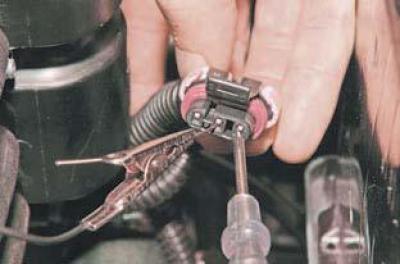We remove the tip of the high-voltage wire from the spark plug and insert a working spark plug into it.

We arrange the candle so that there is contact between the side electrode of the candle and the "mass" of the engine.
To avoid electric shock, when cranking the crankshaft with a starter, do not touch the spark plug and the metal shield of the high-voltage wire tip with your hands.
The assistant, turning the key in the ignition switch to the "START" position, turns the crankshaft.
With a working spark plug, high-voltage wire, ignition coil and its circuits..

... a spark should regularly jump between the electrodes of the candle.
If this is not the case, it is necessary to check the power supply and coil control circuits.
To check the power supply circuit of the coil..

... disconnect the block of the wiring harness of the engine control system from it..

... and connect the tester probes between the "mass" of the engine and the "B" terminal of the wiring harness block.
With the ignition on, the device should detect a voltage equal to the voltage at the battery terminals.
If the voltage value does not correspond to the norm, we check the integrity of the fuse "F15" of the mounting block located in the passenger compartment, as well as the health of the circuit (open or short to ground) between terminal "B" and the ignition switch.
To check the control circuit of the ignition coil, we use a probe with a 1.2 W lamp.

We connect the probe probes to the conclusions "B" and "A" (or to "B" and "C") blocks of the ignition coil control wiring harness and make two measurements.
With serviceable control and power circuits of the ignition coil while cranking the crankshaft with a starter (in both cases) the probe light should blink rapidly.
Otherwise, we check the serviceability of the circuits between terminal "A" of the ignition coil and terminal "M1" of the ECU harness block, as well as between terminal "C" of the ignition coil and terminal "M35" of the ECU harness block.
If the power and control circuits of the ignition coil are working, but when checking on a working candle inserted into the tip of the high-voltage wire, there is no spark (see above), the coil is defective and must be replaced.
To check the ignition coil, disconnect the tips of the high-voltage wires from it.

With a tester, we measure the resistance of the secondary winding of the coil between the high-voltage terminals of the 1st and 4th cylinders.
Similarly, we measure the resistance of the secondary winding of the coil between the terminals of the 3rd and 4th cylinders.
For a working coil, the resistance of the secondary winding should be 5.0–6.0 kOhm.
